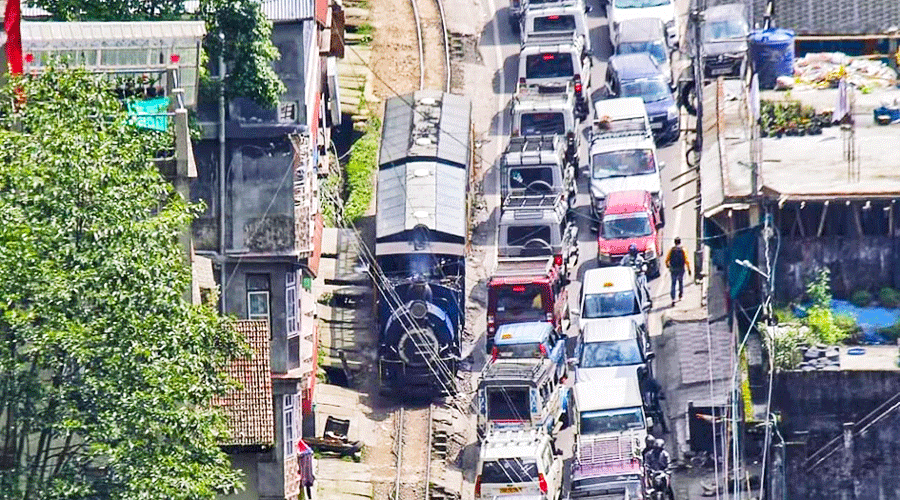Improving Traffic Flow In Darjeeling: A Comprehensive Look

Table of Contents
Identifying the Root Causes of Congestion in Darjeeling
The persistent issue of traffic congestion in Darjeeling stems from a complex interplay of factors. Understanding these root causes is the first step towards finding effective solutions.
Narrow Roads and Inadequate Infrastructure
Darjeeling's hilly terrain and historically narrow roads are major contributors to congestion. The existing infrastructure struggles to cope with the increasing volume of vehicles, especially during peak tourist seasons.
- Limited road widening opportunities due to geographical constraints: The mountainous landscape restricts the possibilities for expanding existing roads.
- Insufficient parking facilities leading to on-street parking and obstruction: A lack of designated parking areas forces vehicles to park on roads, causing significant bottlenecks.
- Lack of proper traffic management systems in certain areas: Inefficient traffic signal management and a lack of clear signage contribute to confusion and delays.
- Aging road surfaces contributing to slower traffic speeds: Poor road conditions necessitate slower driving speeds, further exacerbating congestion. Investing in road resurfacing is crucial for improving Darjeeling traffic flow.
Uncontrolled Tourism and Vehicle Density
The influx of tourists, particularly during peak seasons, significantly increases the number of vehicles on Darjeeling's already limited road network.
- Lack of effective tourist management strategies: Without proper planning and regulation, the sheer number of tourists overwhelms the existing infrastructure.
- Increased private vehicle usage over public transport: A preference for private vehicles over public transport contributes to higher traffic density.
- Inadequate regulation of commercial vehicles: Poorly managed commercial traffic, including taxis and goods vehicles, adds to the congestion. Implementing stricter regulations on commercial vehicle movement during peak hours could improve Darjeeling traffic flow.
Inefficient Public Transportation Systems
Existing public transport systems, while present, are often inadequate to meet the demands of the population and tourists.
- Insufficient frequency of buses and other public transport options: Long waiting times for buses deter people from using public transport.
- Overcrowding on existing public transport: Overcrowded buses are uncomfortable and discourage ridership.
- Limited connectivity to remote areas: Inadequate public transport connectivity to outlying areas forces residents to rely on private vehicles. Improving public transport connectivity is essential for reducing reliance on private vehicles and thus improving Darjeeling traffic flow.
Implementing Solutions for Improved Darjeeling Traffic Flow
Addressing the root causes of congestion requires a multifaceted approach incorporating infrastructure improvements, enhanced public transportation, and intelligent traffic management systems.
Infrastructure Improvements
Strategic investment in road infrastructure is crucial for alleviating congestion. This includes not only widening roads where feasible but also improving existing road surfaces and drainage systems.
- Explore alternative routes and bypasses to alleviate pressure on main roads: Constructing alternative routes can divert traffic away from heavily congested areas.
- Invest in improved pedestrian walkways and cycling lanes to encourage alternative modes of transport: Promoting non-motorized transport options reduces the number of vehicles on the roads.
- Construct multi-story parking garages to reduce on-street parking: Providing ample parking space minimizes on-street parking and improves road space.
Enhancing Public Transportation
Modernizing and expanding the public transport system is crucial for reducing reliance on private vehicles. This involves increasing bus frequency, introducing new routes, and implementing better scheduling.
- Introduce electric or hybrid buses to reduce emissions and improve efficiency: Sustainable transportation options are both environmentally friendly and efficient.
- Improve the accessibility and affordability of public transport: Making public transport more convenient and affordable encourages more people to use it.
- Implement a smart ticketing system for efficient fare collection: A modern ticketing system reduces waiting times and improves overall efficiency.
Intelligent Traffic Management Systems
Implementing smart traffic management systems can optimize traffic flow and reduce congestion significantly.
- Install intelligent traffic management systems at major intersections: Adaptive traffic signals can optimize traffic flow in real time.
- Utilize technology for real-time traffic monitoring and incident management: Real-time monitoring allows for swift responses to incidents, minimizing disruption.
- Implement traffic calming measures in residential areas: Speed bumps and other traffic calming measures reduce speeds and improve safety in residential areas.
Promoting Sustainable Transportation Alternatives
Encouraging the use of sustainable transport options such as walking, cycling, and electric vehicles further reduces the burden on the existing road network.
- Develop dedicated cycling lanes and pedestrian walkways: Providing safe and convenient infrastructure for non-motorized transport encourages their use.
- Provide incentives for electric vehicle adoption: Subsidies and other incentives can promote the adoption of cleaner transportation options.
- Promote carpooling and ride-sharing initiatives: Reducing the number of vehicles on the road through carpooling and ride-sharing initiatives helps improve Darjeeling traffic flow.
Conclusion
Improving Darjeeling traffic flow is a critical issue demanding a multi-pronged approach. Addressing the root causes of congestion through infrastructure improvements, enhanced public transportation, intelligent traffic management systems, and promoting sustainable alternatives are crucial steps towards creating a more efficient and enjoyable experience for both residents and tourists. By implementing these strategies, Darjeeling can retain its charm while effectively managing its growing transportation needs. Let's work together to improve Darjeeling traffic flow and preserve the beauty of this hill station for generations to come.

Featured Posts
-
 A Humorous Perspective Horners View Of Verstappens Fatherhood
May 05, 2025
A Humorous Perspective Horners View Of Verstappens Fatherhood
May 05, 2025 -
 Carte Ufc Des Moines Mise A Jour Sidey Affrontera Robertson Du Canada
May 05, 2025
Carte Ufc Des Moines Mise A Jour Sidey Affrontera Robertson Du Canada
May 05, 2025 -
 Ufc Bogeymans Epic Seven Fight Run Ends In Controversial Mc Gregor Sparring Partner Knockout
May 05, 2025
Ufc Bogeymans Epic Seven Fight Run Ends In Controversial Mc Gregor Sparring Partner Knockout
May 05, 2025 -
 Trae Youngs Historic Game Propels Hawks Past Sixers
May 05, 2025
Trae Youngs Historic Game Propels Hawks Past Sixers
May 05, 2025 -
 Spotify Payment Flexibility How To Pay On I Phone
May 05, 2025
Spotify Payment Flexibility How To Pay On I Phone
May 05, 2025
